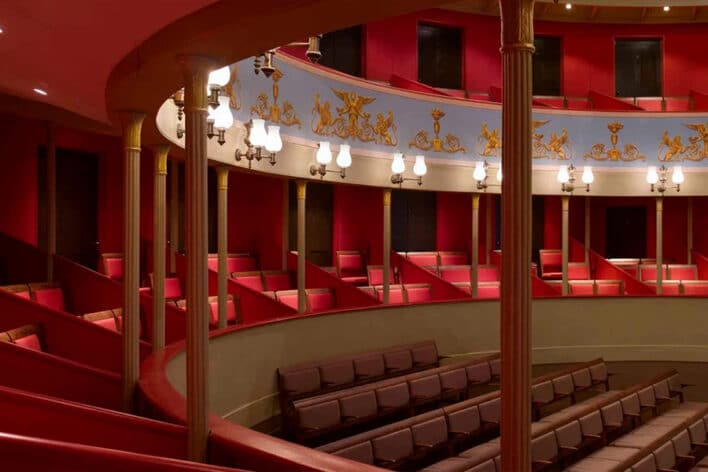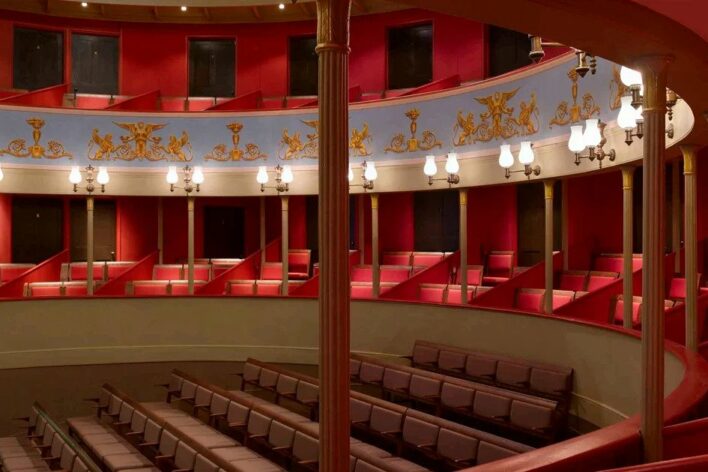“The Georgian theatre was one of the vital periods of our artistic history; and these buildings, with their intimacy and their sense of human proportion, are masterpieces. Bury’s Theatre Royal is perhaps even more precious than we think.”
– Sir Peter Hall CBE
An important piece of history
Theatre Royal was designed and built-in 1819 by William Wilkins. With many of its original features still intact, it is the last remaining Regency playhouse in the country and one of the most beautiful, intimate and historic theatres in the world. Theatre Royal’s designer, William Wilkins (1778-1839) was an architect of national repute responsible for the National Gallery in London and Downing College, Cambridge.
He opened Theatre Royal Bury St Edmunds on 11 October 1819. As the proprietor of the Norwich circuit, he employed a small company of players to undertake an annual tour of six theatres; Yarmouth, Ipswich, Cambridge, Bury St Edmunds, Colchester and Kings Lynn. Each was open for just one or two short seasons during the year. Theatre Royal Bury St Edmunds opened for the Great Fair in early October to mid-November and was only available for special events at other times of the year. At that time, it would certainly have enjoyed large audiences, particularly as the local community would not have been able to travel far for entertainment until the arrival of the railway in the 1840s.

“Theatre Royal Bury St Edmunds holds a unique place in the history of theatre in this country as well as a special place in my heart.”
– Dame Judi Dench CBE
“My enthusiasm for the restoration of Theatre Royal at Bury St Edmunds knows no bounds. it is a vital piece of our theatrical heritage.”
– Stephen Fry
Restored to its Regency origins
The Norwich comedians were disbanded in 1843 and in Bury St Edmunds, there followed more than half a century of economic difficulty and theatrical gloom. This was alleviated briefly in 1892 when the world premiere of Charley’s Aunt was staged at the theatre. In 1903, Theatre Royal was closed but opened again in 1906 when alterations to the building were made by the architect Bertie Crewe. Greene King, the local brewery, purchased the freehold in 1920 and still owns it today. However, in 1925, in the face of overwhelming competition from two new cinemas, Theatre Royal closed once more. Greene King had struggled to keep the theatre in operation but was now content to use the building as a barrel store.
It remained as such until the 1960s when a group from the local community, led by Air Vice Marshall Stanley Vincent, raised over £37,000 to restore and re-open Theatre Royal in 1965. The building was vested in the National Trust in 1975 on a 999-year lease. Theatre Royal is now managed as an independent working theatre by Bury St Edmunds Theatre Management Limited. From 2005 to 2007, Theatre Royal was renovated and restored to its Regency origins. Its extraordinarily intimate auditorium and the exquisite decorative scheme provides visitors with an unforgettable and unique theatrical experience.
“It is not often, in one’s lifetime, that one is fortunate enough to be associated with a project of real significance. During my career, I have worked in many fine theatres across the country, indeed the world. Yet theatre royal in Bury St Edmunds holds an unrivalled place in my thoughts. Once restored this fabulous theatre will be able to achieve something of real significance.”
– Timothy West CBE, Patron of the Restoration Appeal
 Account
Account


